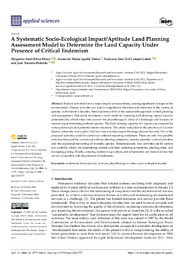Please use this identifier to cite or link to this item:
https://hdl.handle.net/11000/37879Full metadata record
| DC Field | Value | Language |
|---|---|---|
| dc.contributor.author | Blesa-Marco, Zbigniew-Emil | - |
| dc.contributor.author | Agulló-Torres, Asunción-María | - |
| dc.contributor.author | Del Campo-Gomis, Francisco-José | - |
| dc.contributor.author | Navarro-Pedreño, José | - |
| dc.contributor.other | Departamentos de la UMH::Agroquímica y Medio Ambiente | es_ES |
| dc.date.accessioned | 2025-11-06T08:51:40Z | - |
| dc.date.available | 2025-11-06T08:51:40Z | - |
| dc.date.created | 2024-12-17 | - |
| dc.identifier.citation | Applied Sciences, 2024, 14(24), 11775 | es_ES |
| dc.identifier.issn | 2076-3417 | - |
| dc.identifier.uri | https://hdl.handle.net/11000/37879 | - |
| dc.description.abstract | Human activities have a major impact on ecosystems, causing significant changes in the environment. Human activities can lead to a significant alteration and reduction in the variety of species. In the last few decades, there has been a shift in the sustainable approach to land planning and management. This article introduces a novel model for assessing land planning impact/capacity systematically, which takes into account the phytobiological value of a landscape and focuses on conserving and restoring endemic species. The land carrying capacity of a region was assessed for various land uses and potential future situations. The study took place in the province of Alicante (Spain), where the native plant Vella lucentina was discovered. Findings showed that only 34% of the proposed activities could be carried out without impacting endemism. There are only two possible activities that could be carried out without affecting endemism, namely scientific–cultural activities and the occasional harvesting of aromatic species. Simultaneously, four activities can be carried out carefully, which are maintaining current activities, restoring ecosystems, planting trees, and managing grazing. Finally, camping, extensive agriculture, and urbanization are three activities that are not compatible with the presence of endemism. | es_ES |
| dc.format | application/pdf | es_ES |
| dc.format.extent | 21 | es_ES |
| dc.language.iso | eng | es_ES |
| dc.publisher | MDPI | es_ES |
| dc.rights | info:eu-repo/semantics/openAccess | es_ES |
| dc.rights | Attribution-NonCommercial-NoDerivatives 4.0 Internacional | * |
| dc.rights.uri | http://creativecommons.org/licenses/by-nc-nd/4.0/ | * |
| dc.subject | endemism | es_ES |
| dc.subject | land capacity | es_ES |
| dc.subject | land use | es_ES |
| dc.subject | phytobiological value | es_ES |
| dc.subject | socio-ecological models | es_ES |
| dc.subject.other | CDU::5 - Ciencias puras y naturales | es_ES |
| dc.title | A Systematic Socio-Ecological Impact/Aptitude Land Planning Assessment Model to Determine the Land Capacity Under Presence of Critical Endemism | es_ES |
| dc.type | info:eu-repo/semantics/article | es_ES |
| dc.relation.publisherversion | https://doi.org/10.3390/app142411775 | es_ES |

View/Open:
10_applsci-14-11775.pdf
2,85 MB
Adobe PDF
Share:
.png)
